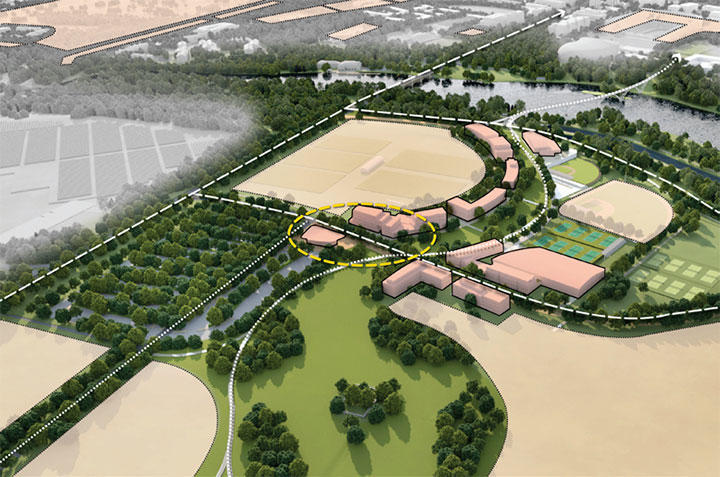A Visionary Campus Plan to Support Princeton’s Mission
Princetonians have strong opinions about the campus. We remember and treasure it for many things: serendipitous encounters, quiet reflection, vigorous exercise, meaningful conversation, spiritual enrichment, and world-class teaching and research, to name only a few. We debate the merits of new additions to its architecture, and we care deeply about what comes next. I accordingly expect that most alums will take great interest in our recently published campus plan. The plan examines how Princeton’s campus can accommodate new fields of study, a growing and evolving student body, and a changing world, while also sustaining the values and characteristics that define our mission and make this University distinctive and beloved. It aims not only to provide a plan for the next decade, but to situate that plan within a longer, and necessarily more speculative, 30-year horizon.
Our campus, like virtually all university campuses, has grown over time along with the scope of scholarly knowledge and the number of students seeking admission to its undergraduate and graduate programs. Through each stage of this expansion, Princeton has remained a place where spirits soar, where scholars embark on new frontiers of discovery, and where students and faculty pursue excellence in all that they do.
We have again reached a moment when our mission provides compelling reasons to extend this tradition of growth. Demand for admission is greater than ever. Princeton’s distinctive capacities for teaching and research are both increasingly valuable and also — as governments cut funding for education, scholarship, and the arts — increasingly rare. Technological advancement has transformed the questions scholars in all fields can ask and the methods they can use to make a positive impact on our world.
We charged our campus planners with ensuring that as we evolve, we do so in ways that support our mission over both the near and longer terms. They have presented an array of attractive options that permit us to pursue our strategic objectives and preserve our ability to adapt to the changing needs of our community and the world.
One of the most intriguing ideas to emerge from this planning process is a vision for activating our lands south of Lake Carnegie. The lands are immediately across the lake, reachable within 10 minutes on bicycle from any of our dormitories or academic departments. Our rugby fields and cross country course are there already, and the canal tow path is a favored and frequently used site for recreation and exercise.
Princeton first began to acquire property south of the lake in 1922. The trustees predicted that “these properties will be needed by the University in the next fifty years,” and they acquired two additional farms in 1945 and 1948. The judgment of 1922 was prescient, even if the timeline was off: almost 100 years later our new plan represents the first time we have articulated a strategy for using these lands.
The plan envisions that Princeton’s academic departments and undergraduate housing would remain on the campus north of the lake, while the new Lake Campus becomes home to a dynamic, mixed-use community that would advance other priorities. New facilities would strengthen our ties to the region’s innovation ecosystem and create opportunities for research partnerships with the nonprofit, corporate, and government sectors. Housing for up to 500 graduate students, retail stores, convening space, and administrative offices would all contribute to a vibrant community. Inviting walkways, plazas, and natural vistas would foster chance encounters and conversations abuzz with creativity and curiosity.
Strategic use of these lands south of the lake would enable us to fulfill our mission more effectively in other areas as well. For example, creating new homes for our softball and tennis teams on the Lake Campus would allow us to build new residential colleges south of Poe Field and admit more students to Princeton. New facilities would also benefit these athletic programs, and perhaps others in the future, through enhancements that are difficult to achieve in their current locations.
Similarly, a Lake Campus transit hub, shuttle service, and improved routes for walking and cycling would enhance connections across the lake, allowing us to relocate some existing parking spaces and reduce our reliance on singleoccupancy vehicles. We would thereby create new capacity for research and teaching facilities north of the lake.
The plan pays careful attention to preserving the special qualities so many of us cherish. It also suggests new ways to develop the beauty and character of Princeton’s campus, including by embracing New Jersey’s native woodlands and meadows along with the cultivated gardens and courtyards that President James McCosh envisioned in an 1875 report to the trustees.
Moving forward, Princeton has an opportunity to infuse its distinctive tradition of campus design with a renewed spirit of collaboration, inclusivity, and sustainability that will enhance the University’s capacity to address some of the most pressing problems facing society today. As you peruse the campus plan, I hope you will share the sense of excitement I feel as I imagine the possibilities described within its pages.












No responses yet